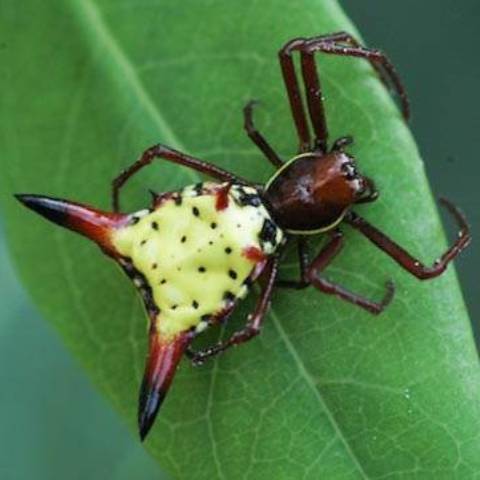

Spotted Orbweaver, Neoscona crucifera (bottom right)
Returning from a Friday evening out, you park your car in the driveway and notice an enormous, circular web built above your sidewalk. Closer inspection reveals a fuzzy spider with banded legs perched in the center. You cringe and hurry inside. After breakfast the next morning, you tell the family about your sighting and drag everyone out to see the spider. The web and the spider are gone! Well, not exactly. Spotted Orbweavers hunt from a web by night, but they sleep in seclusion all day. When darkness falls, the female spider spins her orb, using sticky silk to capture flying insects while we sleep. About an hour before the birds wake up, she reverses her web construction, eating the silk before retreating to a curled leaf. As fall approaches, larger orbweavers sometimes leave their webs up all day- taking a big risk to nourish their precious eggs. So, if you discover a Spotted Orbweaver at your house this fall, help a mother out and toss a cricket in the web.
Carolina Wolf Spider, Hogna carolinensis (top right and left)
Want to do something crazy this Saturday night? Walk into the dark woods with a few friends, armed with only small flashlights. Hold your flashlight handle to the side of your head (line it up with your eyes) and look down to the illuminated circle on the forest floor. If you see light-blue sparkles scurrying about, you have found the closest thing in nature to those freakishly fast vampires on the big screen. Wolf spiders, like all spiders, drink their meals; however, unlike vampires, they use venomous fangs to completely liquefy their prey before they slurp. Wolf spiders hunt without webs, instead relying on incredible quickness and eight-legged agility to subdue prey. These silver-dollar-sized spiders are also intrepid mothers. Instead of making an eggsac and withering away like Charlotte, a wolf spider drags her enormous eggsac behind her for weeks until it erupts. Then, spidermom invites her spiderlings to ride on her weary back for several more weeks until they are ready to hunt on their own.
Spiny Orbweaver, Micrathena sagittata (lead photo)
If you have ever run into a spider web on a wooded trail and freaked out, it is likely that you have had a close encounter with a Spiny Orbweaver. The females of these dainty spiders build orb-shaped (circular) webs in forest openings and feed on small flying insects. The tiny males can be found hanging on single strands near female webs. There are several species of spiny orbweavers in Georgia, all with spiked abdomens. There is even one species whose body looks remarkably similar to bird excrement -- the perfect deterrent for would-be avian predators.
White-banded Crab Spider, Misumenoides formocipes (bottom left)
Lurking in a flower near you, stalking hapless butterflies and bees, is a spider with mysterious superpowers. Recent studies suggest that crab spiders are one of only a few animals capable of actively changing color to match their surroundings. Certainly, a white spider waiting in a white flower is unlikely to be spotted by a passing gardener. Yet, the tricks that Crab Spiders play can go far beyond simple camouflage. Shine an ultraviolet light on a crab spider in ambush and you will see the complete opposite of cryptic coloration. To understand spider strategy, you must know that bee-pollinated flowers appear quite different under UV light, often revealing contrasting stripes leading to the nectary of a flower (i.e. a uniformly yellow flower can appear white with dark purple in the center). And, bees and other pollinating insects see light in the UV spectrum but lack the ability to differentiate reds from greens. Crab spiders appear to be exploiting the UV sensitivity of insects in some way. Experimental investigations have shown that, if given a choice, bees will preferentially visit UV-reflecting flowers with non-reflecting crab spiders near the nectary. Maybe one of our young scientists can come up with an experiment to learn more about this crab spider mystery.
http://www.nature.com/scitable/knowledge/library/perceptual-worlds-and-sensory-ecology-22141730